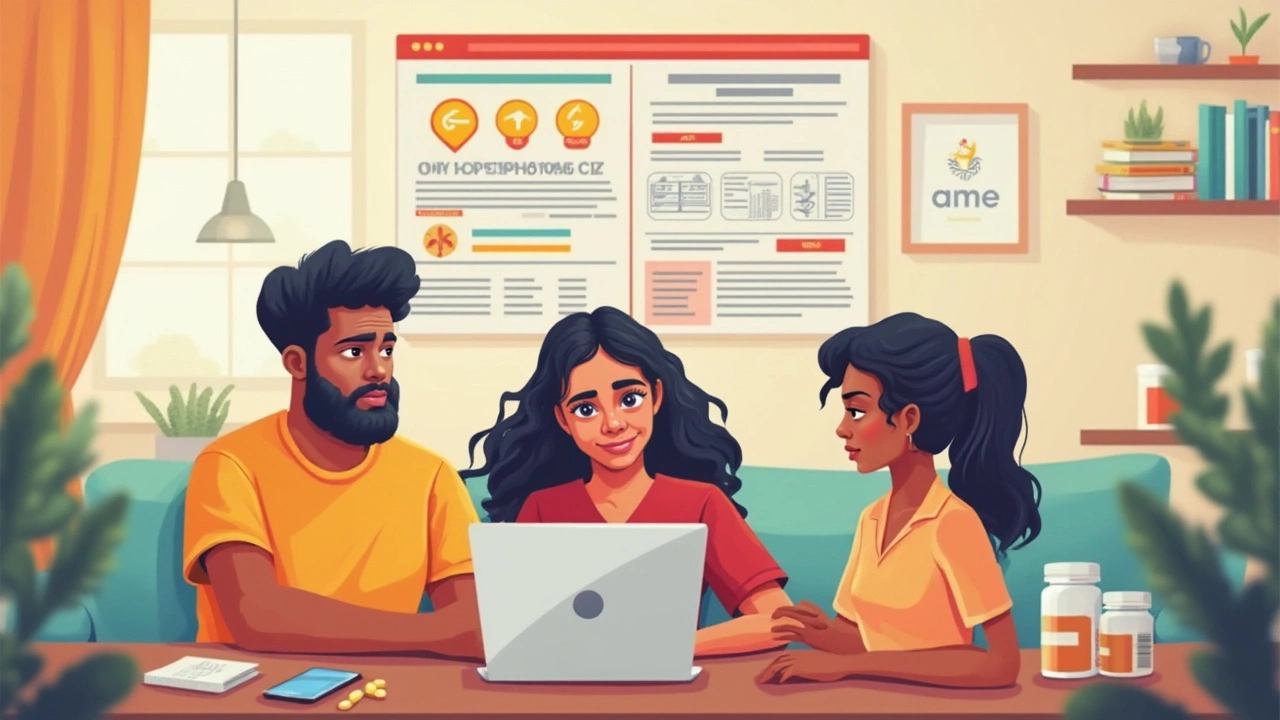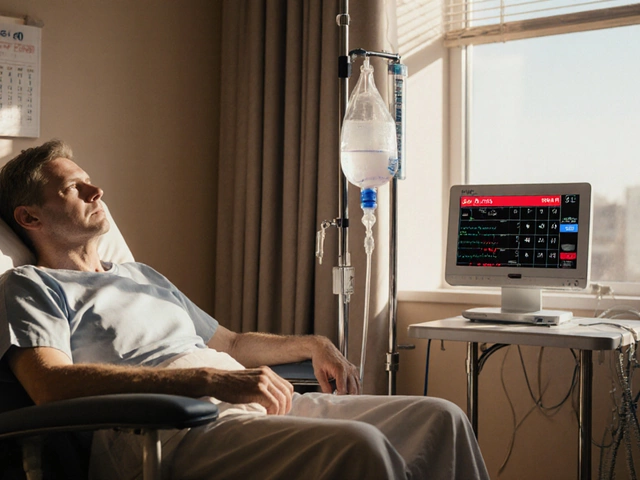- Home
- ::
- Legit Online Pharmacies: How to Spot the Real Ones Fast

Legit Online Pharmacies: How to Spot the Real Ones Fast
Ever searched for medicine online and felt a little uneasy? You're not alone. Even my neighbor freaked out after his credit card info got swiped from a sketchy site. The good news? It’s way easier to pick legit online pharmacies than many people think—you just need to know what to check.
Here’s what I learned the hard way. Real online pharmacies aren’t shy about listing their licenses or showing off approval seals from organizations like NABP (National Association of Boards of Pharmacy) or LegitScript. If you don’t see those, be suspicious. Another dead giveaway? Any site offering prescription meds without asking for an actual prescription. Run from those. Honestly, if a website seems a little too eager to sell you antibiotics or painkillers, it’s probably not the real deal.
If you’re thinking, “But how can I REALLY be sure?”—relax, it’s not rocket science. Checking for a valid, physical address, clear contact info, and a pharmacist you can talk to are solid signs you’re on a trustworthy site. Stick around, and I’ll show you exactly what to look out for (and what to run from) when you order meds online, so you don’t get scammed or end up with something sketchy in your mailbox.
- Why People Worry About Online Pharmacies
- The Fastest Ways to Spot a Legit Site
- Red Flags: Obvious Scams You Can Avoid
- Tips for Staying Safe Every Time
Why People Worry About Online Pharmacies
You hear wild stories about people getting sugar pills or worse instead of real medicine from online pharmacies. Honestly, that’s not just a rumor. According to the World Health Organization, over half of the sites selling medicines online don’t follow any safety standards at all. That’s a huge risk, because the wrong pill can actually land you in the hospital.
One big worry is fake medicine. Some shady websites sell drugs that look right but have the wrong ingredients, no active ingredient, or sometimes even stuff that could make you sick. There have been real cases where people got antibiotics or heart meds online and ended up getting sicker because what they got didn’t work—and that’s scary.
People are also worried about their personal info. Weak sites often have lousy security, so your name, address, or even your credit card number can land in the wrong hands. Some scam sites have been known to steal identities or rack up bogus charges on your card. That’s a headache nobody needs.
It’s not just about money—it’s about health. Medicine that shows up in damaged bottles or without proper packaging can spoil or get contaminated. Kids, like my son Ishaan, rely on safe medicine. So do our pets; try explaining to Leo if his flea meds are actually sugar!
Here’s what makes people think twice before using these sites:
- Sites selling prescription drugs without needing your actual prescription.
- Super-low prices that look too good to be true. (They usually are.)
- No sign of licensing or any proper contact info.
- Lots of spammy ads in your inbox after you visit the site.
So, worrying about finding legit online pharmacies isn’t just paranoia. When it comes to your health and your wallet, it pays to be picky.
The Fastest Ways to Spot a Legit Site
If you've ever felt lost scrolling endless online pharmacy options, you're not alone. There are wild numbers out there: in 2024, NABP found 95% of online pharmacies are breaking the rules. So, knowing shortcuts to find a legit online pharmacy really matters.
Here’s the peanut butter and jelly checklist to stay safe:
- Look for Certification Badges: Trust seals like "VIPPS" (Verified Internet Pharmacy Practice Sites) from NABP or a LegitScript approved seal mean the site is following the rules. Click the badge—it should take you to a real verification page, not just an image.
- Prescription Required? If the website sells prescription meds without making you show a real prescription, it’s a huge warning sign. Real pharmacies check (every single time).
- Pharmacist on Call: Legit sites always have a licensed pharmacist you can call or email with questions. No contact button? That’s sketchy.
- Physical Address and Phone Number: If you can’t find a real, traceable U.S. or Canadian street address and working phone number in the contact info, don’t even bother.
- Check with NABP or FDA: NABP runs a free online tool called “Safe Pharmacy,” and the U.S. FDA has its own list. Just type in the site name and see if they show up as safe.
Here’s a quick table you can screenshot if you forget what to check:
| What to Check | Legit Pharmacy | Fake Pharmacy |
|---|---|---|
| Certification Badge | Yes, verified | No, or fake image only |
| Prescription Required | Always | No |
| Pharmacist Available | Yes, real person | No |
| Contact Info | Real address, phone | Missing, P.O. box, odd country |
| FDA/NABP Listed | Yes | No |
This stuff isn’t just for show, either. In April 2023, Interpol seized over 3 million fake medicines worldwide from dodgy online shops. So, stick to these basic checks and you’ll save yourself a headache—and maybe way worse.

Red Flags: Obvious Scams You Can Avoid
If you’re looking to buy from online pharmacies, spotting a scam can save you a ton of trouble—not just wasted cash, but possibly your health, too. It’s wild: the FDA says around 97% of online pharmacies are operating illegally or not following safe pharmacy laws. That makes it super important to know the warning signs.
- No Valid Prescription Needed: If a site is cool with selling prescription meds without a real prescription, back away. Any legit pharmacy is legally required to check your script from an actual doctor. Full stop.
- Missing Contact Info: No phone number, address, or landline? That’s a red flag. Real pharmacies make it easy to reach them, and most even have a licensed pharmacist ready to answer questions.
- Crazy Low Prices: Cheap isn’t always a good thing. If prices seem way below what you’d pay anywhere else (like 90% off name-brand meds), something’s fishy. Scammers hope people are tempted by unrealistic deals.
- Weird Website Design: Messy layouts, random pop-ups, or tons of typos often mean a site was thrown together fast. Trustworthy pharmacies invest in quality websites because they deal with sensitive info.
- Refusing to Show Credentials: If you can’t find a state license or NABP seal, or they dodge your questions about it, it’s wiser to walk away. These badges are not just for show; they matter.
- Shipping from Unknown Locations: You order from a “US-based” site, but the meds ship from India or somewhere totally unexpected. That’s sketchy, and you could get counterfeit stuff.
Look, these scams aren’t just annoying—they can be dangerous. The World Health Organization says fake medicines are a billion-dollar business, and half the meds bought from shady online sources are probably fake. Check this out:
| Red Flag | Why It’s Risky |
|---|---|
| No prescription required | Bypasses legal and medical protections |
| Unreal low prices | Often paired with counterfeit or expired drugs |
| No pharmacy license or seal | No oversight or quality guarantee |
| Vague or hidden shipping info | Hard to trace, risk of smuggled meds |
A good line from the FDA sums it up:
"If an online pharmacy is willing to break the law regarding prescriptions, there’s a good chance they’ll break the law when it comes to delivering safe medicine, too."
If you spot any of the stuff above, don’t risk it—even if the deal seems too good to be true. Always double-check before entering your info. My policy? If it feels off, it probably is.
Tips for Staying Safe Every Time
Think you’ve found a deal too good to be true? Trust your gut, but let’s back it up with some solid steps you can take every time you’re about to hit “buy.”
- Stick to verified sites: Double-check if the pharmacy is listed on NABP’s Safe Pharmacy or carries the LegitScript seal. These aren’t just logos—they mean someone’s actually checked the pharmacy for safety and rules.
- Use prescription-only sites: A legit online pharmacy always asks for a real prescription. No exceptions, even if you see ads for “no prescription needed.”
- Watch for clear addresses and phone numbers: Real pharmacies give you their physical address and have an actual person answer the phone—not just a chat bot or auto reply.
- Check secure payment and privacy policies: Look for “https://” in the address bar and read how they protect your info. If you’re ever confused, look for a privacy policy.
- Compare prices with your local pharmacy: If the medicine is crazy cheap, that’s usually a red flag. Sometimes low prices mean counterfeit or expired meds.
Here’s a quick overview you can save or screenshot:
| What To Check | Why It Matters |
|---|---|
| License or Certification | Proves it’s regulated (look for NABP, CIPA, LegitScript) |
| Prescription Required | Guarantees proper medical oversight |
| Secure Website (https://) | Keeps your payment and health data safe |
| Physical Address & Phone | Makes the site traceable and accountable |
| Consultation with Licensed Pharmacist | Lets you double-check meds before you buy |
Nearly 95% of online pharmacies across the globe don’t meet safety or legal standards, according to NABP. The bottom line? The more boxes you check, the safer you are. Treat your online pharmacies hunt like you’re picking a babysitter for your kid or a new vet for the family dog—trustworthy, open, and with plenty of legit references.

 Health and Wellness
Health and Wellness





Write a comment